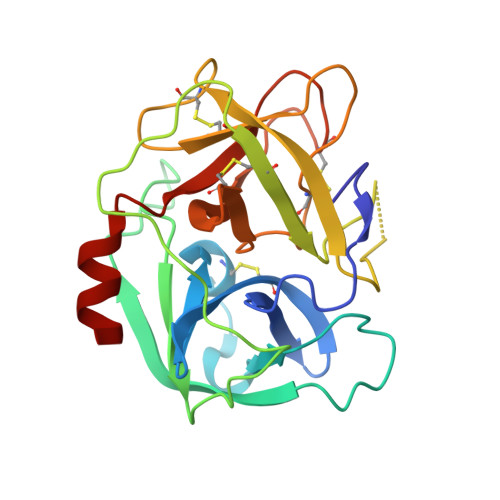Neutrophil elastase inhibitors for the treatment of (cardio)pulmonary diseases: Into clinical testing with pre-adaptive pharmacophores.
von Nussbaum, F., Li, V.M.(2015) Bioorg Med Chem Lett 25: 4370-4381
- PubMed: 26358162
- DOI: https://doi.org/10.1016/j.bmcl.2015.08.049
- Primary Citation of Related Structures:
5ABW - PubMed Abstract:
Alpha-1 antitrypsin deficiency is linked with an increased risk of suffering from lung emphysema. This discovery from the 1960s led to the development of the protease-antiprotease (im)balance hypothesis: Overshooting protease concentrations, especially high levels of elastase were deemed to have an destructive effect on lung tissue. Consequently, it was postulated that efficient elastase inhibitors could alleviate the situation in patients. However, despite intensive drug discovery efforts, even five decades later, no neutrophil elastase inhibitors are available for a disease-modifying treatment of (cardio)pulmonary diseases such as chronic obstructive pulmonary disease. Here, we critically review the attempts to develop effective human neutrophil elastase inhibitors while strongly focussing on recent developments. On purpose and with perspective distortion we focus on recent developments. One aim of this review is to classify the known HNE inhibitors into several generations, according to their binding modes. In general, there seem to be three major challenges in the development of suitable elastase inhibitors: (1) assuring sufficient potency, (2) securing selectivity, and (3) achieving metabolic stability especially under pathophysiological conditions. Impressive achievements have been made since 2001 with the identification of potent nonreactive, reversible small molecule inhibitors. The most modern inhibitors bind HNE via an induced fit with a frozen bioactive conformation that leads to a significant boost in potency, selectivity, and stability ('pre-adaptive pharmacophores'). These 5th generation inhibitors might succeed in re-establishing the protease-antiprotease balance in patients for the first time.
- Bayer HealthCare AG, Medicinal Chemistry Berlin, 13353 Berlin, Germany. Electronic address: franz.nussbaum@bayer.com.
Organizational Affiliation:



















